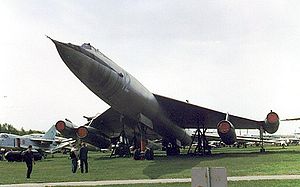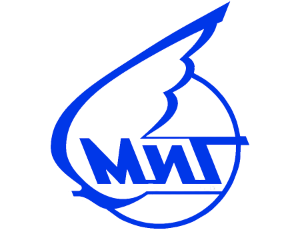Myasishchev
M-50/52 Bounder
 |
|
| Myasishchev M-50 on display at Monino Aviation Museum | |
| Role | Supersonic strategic bomber |
|---|---|
| National origin | Soviet Union |
| Manufacturer | Myasishchev |
| First flight | 27 October 1959 |
| Status | Retired |
| Primary user | Soviet Union |
| Number built | 1 (+1 static test airframe), 1 M-52) |
|
|
.
History V. M. Myasishchev Experimental Design Bureau Myasishchev M52 M-50 "Bounder"

The Myasishchev M-50 (Russian: Мясищев М-50; NATO reporting name Bounder) is a Soviet prototype four-jet engine supersonic strategic bomber which never attained service. Only one flightworthy prototype was built, which was first flown in October 1959. The M-50 was constructed by the Myasishchev design bureau.
Design and development
The M-50 was a fast jet bomber with four engines: two Dobrynin VD-7 non-afterburning turbojet engines at the outer and two VD-7F afterburning turbojet engines at the inner positions. The two inner engines were located under the wing, and the two outer on the wingtips of its shoulder-mounted, truncated delta wings.
The second aircraft was designated M-52 and carried Zubets 16-17 turbofans, around which the aircraft had been designed The engine installation was modified, and a second tailplane added to the top of the fin.The fore-end of the M-52 has been redesigned: in place of the tandem cockpit of the M-50 with seats in a row, the M-52 had a wider cockpit with the two pilots sitting side by side.The M-50 participated in a Soviet Aviation Day flyby in 1961. The M-52 was completed but was not flight-tested.
An unmanned M-51 intercontinental cruise missile variant was developed, which would have delivered multiple warheads on targets in the contiguous United States.
Like most of the early 1960s supersonic strategic bomber projects, the M-50/52 program was terminated due to the development of intercontinental ballistic missiles and the priority assigned to the Soviet space program.

0
KmCeiling
0
KmCombat RANGE
0
Km/hAircraft Speed
0
Max Crew
Photo Gallery
V. M. Myasishchev Experimental Design Bureau
Myasishchev M52 M-50 "Bounder"


V. M. Myasishchev Experimental Design Bureau
Myasishchev M52 M-50 "Bounder"
General Info
-
-
-
- Crew: 2
- Length: 57.48 m (188 ft 7 in)
- Wingspan: 25.10 m (82 ft 4 in)
- Height: 8.25 m (27 ft 1 in)
-
-
Powerplant
- Empty weight: 85,000 kg
- Gross weight: 175,000 kg
- Max takeoff weight: 200,000 kg
- Powerplant: 2 × Dobrynin VD-7F afterburning turbojet, 137.29 kN (30,865 lbf) thrust each wet
- Powerplant: 2 × Dobrynin VD-7 non-afterburning turbojet, 110 kN (24,000 lbf) thrust each
-
Performance
- Maximum speed: 1,950 km/h
- Cruise speed: 1,500 km/h
- Range: 7,400 km
- Service ceiling: 16,500 m
Armament
-
- 30,000 kg (66,000 lb) of bombs or missiles carried in internal bays, including M-59 and M-61 long-range cruise missiles
-
.
Links to Youtube & Others
From the beginning, the U-2 became the basic Soviet civil and military trainer aircraft, mass-produced in a "Red Flyer" factory near Moscow. It was also used for transport, and as a military liaison aircraft, due to its STOL capabilities. Also from the beginning it was produced as an agricultural aircraft variant, which earned it its nickname Kukuruznik. Although entirely outclassed by contemporary aircraft, the Kukuruznik served extensively on the Eastern Front in World War II.
V. M. Myasishchev
M52 M-50 "Bounder"
The aircraft was designed by Nikolai Polikarpov to replace the U-1 trainer (a copy of the British Avro 504), which was known as Avrushka to the Soviets.
Youtube Link
The Polish Air Force used these slow and manoeuvrable aircraft for air reconnaissance and COIN operations against UPA detachments in mountainous area of Bieszczady.








.png)



